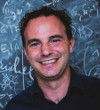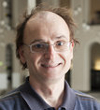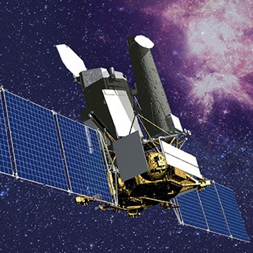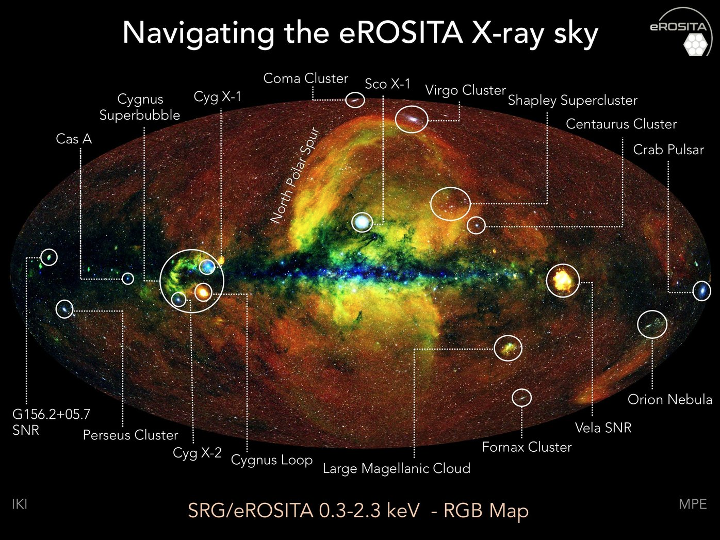 |
Ahmed
Almheiri |
Entropy of the Hawking radiation
Hawking showed that the von Neumann or fine-grained entropy of the radiation emanating from an evaporating black hole monotonically increases throughout the black hole’s lifetime. This suggests that black hole formation and evaporation can evolve a pure quantum state of a collapsing star into a mixed quantum state of the Hawking radiation. This is in direct conflict with the unitarity of time evolution in quantum mechanics, which requires that the radiation entropy vanishes once the black hole has completely evaporated. I will review some recent progress on this issue and discuss a new formula for computing the von Neumann entropy of the radiation that more carefully accounts for the gravitational nature of the theory. It predicts that the entropy of the radiation far away from the black hole can receive contributions from the black hole interior, including a term coming from the area of a surface near the event horizon. I will show how this formula produces an entropy that is consistent with unitary black hole evaporation and gives the so-called “Page curve” of an entropy that initially rises but then ultimately diminishes down to zero. |
| |
 |
Lorenzo
Amati |
Cosmology and Multi-Messenger Astrophysics with Gamma-Ray Bursts
Since their discovery in the late '60s, Gamma-Ray Bursts constitute one of the most fascinating and mysterious phenomena for modern science, with strong implications for several fields of astrophysics and fundamental physics. In this review, I will focus on the perspective key-role of GRBs for cosmology and multi-messenger astrophysics. Indeed, the huge luminosity, the redshift distribution extending at least up to z~10 and the association with the explosive death of very massive stars make long GRBs (i.e., those lasting up to a few minutes) potentially extremely powerful cosmological probes (early Universe, geometry and expansion rate of space-time, "dark energy" evolution). At the same time, short GRBs (lasting no more than ~1-2s) are the most prominent electromagnetic signature of gravitational-wave sources like NS-NS and NS-BH merging events, and both long/short GRBs are expected to be associated with neutrino emission. I will also report on the status of the THESEUS space mission project, aiming at fully exploiting these unique potentialities of the GRB phenomenon. |
| |
 |
Carlos
Argüelles |
Dark matter in the Milky Way: from SgrA * to the entire halo
Relaxation mechanisms of collisionless self-gravitating systems of fermions in cosmology, can lead to spherical equilibrium states which are stable, long-lived, and able to explain the dark matter (DM) halos in galaxies. The most general fermionic DM profile out of such a mechanism, develops a degenerate compact core which is surrounded by an extended halo. When applied to the Milky Way, it is demonstrated that while the outer halo can explain the rotation curve of the Galaxy, the central DM-core explain the dynamics of all the best resolved S-cluster stars orbiting SgrA *, without the need of assuming a central black hole (BH). Interestingly, for the same DM particle mass used to explain the Galactic halo, the critical mass for gravitational collapse of a degenerate fermion DM core into a BH is ∼ 108 Mo. This result may provide the initial seed for the formation of supermassive BH in active galaxies, leading to a paradigm shift in the understanding of galactic cores. |
| |
 |
Abhay
Ashtekar |
Probing singularities of GR with Quantum Fields
Singularity theorems of Penrose and Hawking are based on geodesic incompleteness. Physically, this criterion refers to the fate of classical test particles. What if one uses quantum fields instead? They would be more fundamental probes. For technical simplicity, I will restrict myself to cosmological singularities and show that one can unambiguously evolve quantum fields across them in a rigorous sense. Already for test quantum fields, classical singularities are not absolute boundaries where physics breaks down. I will also discuss the behavior of expectation values of renormalized products of fields. The overall conclusion is that singularities of classical GR are tamer when seen from a quantum perspective, and the quantum considerations provide more refined tools to probe their structure. This work is based on joint work with Tommaso De Lorenzo and Marc Schneider, and supported by the NSF grant PHY-1806356 and the Eberly Chair funds of Penn State. |
| |
 |
Markus
Aspelmeyer |
Gravitational coupling between millimetre-sized masses: prospects for a quantum Cavendish experiment
Earth-based experiments have been continuously increasing their sensitivity to gravity phenomena at laboratory scales. A yet unexplored frontier is the regime of microscopic source masses, which enables studies of fundamental interactions and provides a path towards exploring the quantum nature of gravity. We have recently demonstrated gravitational coupling between a test mass and a 90mg gold sphere, the smallest source mass to date in table-top gravity experiments. The miniaturized torsion balance measurement achieves a systematic accuracy of 3e-11 m/s2 and a statistical precision of 3e-12 m/s2. We expect that further improvements will enable the isolation of gravity as a coupling force for objects well below the Planck mass. This is a practical prerequisite for future “quantum Cavendish” experiments that aim to probe probe gravitational phenomena originating from quantum superposition states of a source-mass configuration. |
| |
 |
Jean-Luc
Atteia |
Exploring the transient sky with the SVOM mission
I will present the SVOM mission that the Chinese National Space Agency and the French Space Agency have decided to jointly implement for a launch in autumn 2022. In the line of Swift, SVOM has been designed to detect, characterize and quickly localize gamma-ray bursts (GRBs) and other types of high-energy transients. For this task, the spacecraft will carry two wide field high-energy instruments: ECLAIRs, a hard X-ray imager, and the Gamma-Ray Monitor, a broadband spectrometer. Upon localizing a transient, SVOM will quickly slew towards the source and start deep follow-up observations with two narrow-field telescopes: the Micro-channel X- ray Telescope in X-rays and the Visible Telescope in the visible. The originality of SVOM is to have a set of instruments deployed on the ground to complete the measurements made in space .i.e. a Wide Angle Camera and two dedicated ground robotic telescopes. The nearly anti-solar pointing of SVOM combined with the fast transmission of GRB positions to the ground thanks to a VHF antenna network will facilitate the observations of SVOM transients by the largest ground based telescopes. All this together makes SVOM a powerful time domain machine. |
| |
 |
Mohammad
Bagheri |
Ulugh Beg's Scientific School in Samarkand
Ulugh Beg was the grandson of Tamerlane who conquered a vast area in Transoxania and Iran around 1400. Mohammad Taraghay, best known as Ulugh Beg (lit. "Grand prince") was born in 1394 in Sultaniya (Zanjan, Iran). In 1409, he became the ruler of Samarkand where he founded a school in 1420 which is still well preserved there. Astronomy was the major subject taught in the school and Ulugh Beg gathered a group of astronomers there. He also founded an observatory in 1424 which was designed by the Iranian scholar Jamshid Kashani (al-Kashi) who upon Ulugh Beg's request, supervised the construction and operation of the observations made there. After Ulugh Beg's tragic murder arranged by his son in 1449, the observatory was destroyed and forgotten. Its remnants were rediscovered in 1908 near Samarkand. The main part of the observatory was a huge stone sextant more than 40 meters long. It measured the meridian transit of celestial bodies from which the declination of the ecliptic, the equinoxes and the geographical latitude of the locality could be determined accurately. The results of the observations were composed in a Persian treatise called Zij Ulugh Beg. Zij is a Persian word used for a collection of astronomical tables with explanations for using them in astronomical calculations. Several commentaries are written on this work and selections of it are translated into Arabic, English, French, Russian and Turkish. Ulugh Beg also devised a method for finding the sine of one degree for which he solved a cubic equation by an iterative method. |
| |

 |
Jiri
Bicak
Tomáš
Ledvinka |
Dragging of inertial frames by matter and waves
We shall analyze three specific general-relativistic problems in which gravitomagnetism plays the important role: the dragging of magnetic fields around rotating black holes, dragging inside a collapsing slowly rotating spherical shell of dust, compared with the dragging by rotating gravitational waves (CQG 34, 205006 (2017), Phys. Rev. D 85 124003, (2012) etc). We shall also briefly show how "instantaneous Machian gauges" can be useful in the cosmological perturbation theory (Phys. Rev. D 76, 063501 (2007)). Finally, we shall mention the "Quantum Detection of Inertial Frame Dragging" (Phys. Rev. D 103, 024027 (2021)). |
| |
 |
Giancarlo
Cella |
The recent observations of Gravitational Waves from the two Neutron Stars - Black Holes coalescences
In January 2020, the LIGO–Virgo detector network observed gravitational-wave signals from two compact binary inspirals which are consistent with neutron star–black hole (NSBH) binaries. These represent the first confident observations to date of NSBH binaries via any observational means. I discuss the characterstic of these events and their level of confidence, what we can learn from them and the perspectives for future detections of the same kind. |
| |
 |
Ignazio
Ciufolini |
Frame-Dragging and its tests with Laser Relativity and Geodesy Satellites
Dragging of inertial frames, or frame-dragging, is an intriguing and fascinating phenomenon of Einstein's theory of General Relativity (GR) with relevant astrophysical implications. Some theories of gravitation, alternative to GR but in agreement with its post-Newtonian tests, predict a different result from GR for frame-dragging. However, frame-dragging tests, in agreement with GR, have been obtained with LARES (LAser RElativity Satellite), of the Italian Space Agency (ASI), successfully launched in February 2012, and with data from the LAGEOS (Laser Geodynamics Satellite), LAGEOS 2 and GRACE (Gravity Recovery and Climate Experiment) satellites. The accuracy of these tests reached a few parts in a hundred. The forthcoming ASI LARES 2 satellite, to be launched in 2021, together with data from the LAGEOS and GRACE Follow-On satellites, is aimed at frame-dragging tests with an accuracy of a few parts in a thousand. |
| |
 |
Mihalis
Dafermos |
The strong cosmic censorship in general relativity
I will review recent progress on our understanding of the issue of strong cosmic censorship in general relativity, including very recent developments in the case of non-zero cosmological constant. |
| |
 |
Selma
De Mink |
Massive Binary Stars in the Era of Gravitational Wave Astrophysics
The direct detection of gravitational waves has triggered excitement from physicist, astrophysicists and general public alike. The first event and many that followed originated from surprisingly heavy systems, with typical masses of 30-45 solar masses, well in excess of the masses of black holes known in X-ray binary systems. How did heavy pairs of Black holes form? What do these measurements tell us about the massive stars that were their progenitors? In this talk I will try to give a taste of the excitement and rapidly developing ideas and new questions about the formation of Gravitational Wave sources and the stars they originate from and what we hope to learn in the near future with next generation detectors. |
| |
 |
Ivan
De Mitri |
Recent advances in the observation of high energy cosmic rays
The study of High Energy (HE) and Ultra-High Energy (UHE) cosmic rays is currently being driven by new and very interesting data from both space-borne and ground-based experiments. The talk will be devoted to a review of recent observations of electrons/positrons, protons/antiprotons, and nuclei, at energies above hundreds of GeV. New techniques and mission concepts will also be briefly discussed. |
| |
 |
George
Efstathiou |
Planck and the H0 tension
The Planck mission found excellent agreement with a spatially flat Universe and fluctuations consistent with simple models of inflationary cosmology. The Planck data are well described by a six parameter model that has become known at the LCDM cosmology. Nevertheless, there have been claims of deviations (or tensions) with the LCDM cosmology both internally to the Planck data and with other astrophysical data. I will discuss an extensive reanalysis of Planck that makes use of more sky. The fit to the LCDM model is improved and there is no evidence for any internal inconsistencies within the Planck dataset. These results are consistent with the new results from ground based polarization experiments. I will then describe some aspects of the so called 'Hubble tension', i.e. the discrepancy between the LCDM value of H0 and the value inferred from the Cepheid distance ladder. I will point out three puzzling aspects of the distance ladder measurement. |
| |
 |
Wendy
Freedman |
The Hubble constant tension
An important and unresolved question in cosmology today is whether there is new physics that is missing from our current standard Lambda Cold Dark Matter (LCDM) model. A current discrepancy in the measurement of the Hubble constant, Ho, could be signaling a new physical property of the universe or, more mundanely, unrecognized measurement uncertainties. I will discuss two of our most precise methods for measuring distances in the local universe: Cepheids and the Tip of the Red Giant Branch (TRGB). I will present new results from the Carnegie-Chicago Hubble Program (CCHP. Using the Hubble Space Telescope Advanced Camera for Surveys, we are using the TRGB to calibrate Type Ia supernovae out into the Hubble flow to provide an independent measurement of Ho. I will address the uncertainties, discuss the current tension in Ho, and whether there is need for additional physics beyond the standard LCDM model. |
| |
 |
Christopher Lee
Fryer |
Probes of the Progenitors, Engines and Physics behind Stellar Collapse
Understanding the nature of the stellar collapse plays an important role in a wide range of astrophysics. Stellar collapse produce the compact remnants (neutron stars and black holes) that make up a menagerie of exotic astrophysics objects from pulsars and X-ray binaries to the merging compact objects detected in gravitational waves. Stellar collapse plays an important role in most gamma-ray burst engines and their supernovae disseminate many of the heavy elements into the universe. But, to understand the true impact of stellar collapse on these phenomena, we must understand the engine driving supernova explosions. Despite recent successes supporting the convection-enhanced, neutrino-driven engine driving these explosions, we are far from a complete picture of these explosions. For example, uncertainties in stellar evolution prior to collapse and the engine itself make quantitative predictions from stellar collapse. Here we review our current understanding of stellar collapse (both the engine and its progenitor stars) and the observations (both current and proposed) to help us improve this understanding. |
| |
 |
Reinhard
Genzel |
A 40-Year Journey
More than one hundred years ago, Albert Einstein published his Theory of General Relativity (GR). One year later, Karl Schwarzschild solved the GR equations for a non-rotating, spherical mass distribution; if this mass is sufficiently compact, even light cannot escape from within the so-called event horizon, and there is a mass singularity at the center. The theoretical concept of a 'black hole' was born, and was refined in the next decades by work of Penrose, Wheeler, Kerr, Hawking and many others. First indirect evidence for the existence of such black holes in our Universe came from observations of compact X-ray binaries and distant luminous quasars. I will discuss the forty year journey, which my colleagues and I have been undertaking to study the mass distribution in the Center of our Milky Way from ever more precise, long term studies of the motions of gas and stars as test particles of the space time. These studies show the existence of a four million solar mass object, which must be a single massive black hole, beyond any reasonable doubt. |
| |
 |
Francis
Halzen |
IceCube: Cosmic Neutrinos and Multimessenger Astronomy
IceCube detects more than 100,000 neutrinos per year in the GeV to 10 PeV energy range. Among those, we have isolated a flux of high-energy neutrinos of cosmic origin, with an energy density in the extreme universe similar to that of high-energy photons and cosmic rays. We identified their first source: on September 22, 2017, following an IceCube neutrino alert, observations by other astronomical telescopes pinpointed a flaring active galaxy, powered by a supermassive black hole, as the source of a cosmic neutrino with an energy of 290 TeV. We will review recent progress in measuring the cosmic neutrino spectrum and in identifying its origin. |
| |
 |
Yuan K.
Ha |
The Irreducible Mass of Christodoulou-Ruffini-Hawking Mass Formula
We reveal three new discoveries in black hole physics previously unexplored in the Hawking era. These results are based on the remarkable 1971 discovery of the irreducible mass of the black hole by Christodoulou and Ruffini,
1. The Horizon Mass Theorem states that the mass at the event horizon of any black hole: neutral, charged, or rotating, is always twice its irreducible mass observed at infinity.
2. The External Energy Theorem asserts that the rotational energy of a Kerr black hole exists completely outside the horizon. This is due to the fact that the irreducible mass does not contain rotational energy
3. The Moment of Inertia Theorem shows that every black hole has a moment of inertia. When the rotation stops, the irreducible mass of a Kerr black hole becomes the moment of inertia of a Schwarzschild black hole. This is recognized as the rotational equivalent of the rest mass of a moving body in relativity.
Thus after 50 years, the irreducible mass has gained a new and profound significance. No longer is it a limiting value in rotation, it determines black hole dynamics and structure. What is believed to be a black hole is a mechanical body with an extended structure. Astrophysical black holes are likely to be massive compact objects from which light cannot escape. |
| |
 |
Wick
Haxton |
The neutrino in stellar evolution and in the Sun
Motivated in part by the recent measurements of the Borexino Collaboration, I will describe the current status of solar neutrino physics, including the impact of measurements on our knowledge of neutrino properties. Questions remain about the sun's metallicity and the equivalence of its weak and electromagnetic luminosities - topics relevantly, respectively, to early solar evolution and to possible "new physics" tests involving solar neutrinos. Additional aspects of the flavor mixing first identified through solar and atmospheric neutrino experiments arise in explosive astrophysical environments, such as supernova cores, neutron star mergers, and the Big Bang. I will describe some of the associated open issues and how they affect current efforts to better characterize such environments through "multi-messenger" observations and analysis. |
| |
 |
Gerhard
Heinzel |
Laser interferometry in space
In the last decade, laser interferometry in space has advanced from planning on ground to an established technique for gravitational physics, both for the detection of gravitational waves (LISA project) as well as for global observation of the Earth gravity field (GRACE Follow-On). I will summarize the past and planned missions including LISA Pathfinder, GRACE Follow-On, Pathfinder missons in China and LISA. |
| |
 |
Margarita
Hernanz |
The enhanced X-ray Timing and Polarimetry mission eXTP: a future X-ray mission to study the state of matter under extreme conditions
The eXTP (enhanced X-ray Timing and Polarimetry) mission is a major project of the Chinese Academy of Sciences (CAS), with a large involvement of Europe and expected ESA support. It is designed to study the state of matter under extreme conditions of density, gravity and magnetism, as for instance what is happening on the vicinity of black holes or what is the state of matter inside neutron stars. Its predicted launch is in 2027. eXTP will carry a unique suite of instruments, enabling for the first time ever the simultaneous spectral-timing-polarimetry studies of cosmic sources in the energy range from 0.5 to 30 keV. The eXTP scientific payload includes four instruments: SFA (Spectroscopy Focusing Array), PFA (Polarimetry Focusing Array), LAD (Large Area Detector) and WFM (Wide Field Monitor). They offer an unprecedented simultaneous wide-band X-ray timing and polarimetry sensitivity. A large European consortium is contributing to the eXTP study, both for the science and the instrumentation, providing two of the four instruments: LAD and WFM. The WFM for eXTP will be a wide field X-ray monitor instrument in the 2-50 keV energy range. Its unprecedented combination of large field of view and imaging down to 2 keV will allow eXTP to make important discoveries of the variable and transient X-ray sky, outstanding contributions to multi-messenger astronomy. |
| |
 |
James Anthony
Hinton |
The Southern Wide-field Gamma-ray Observatory
The Southern Wide-field Gamma-ray Observatory (SWGO), is a new project for gamma-ray astrophysics in the energy range from a few hundred GeV up to a PeV. SWGO will be a steradian field of view, 100% duty-cycle detector, surveying the southern sky and monitoring for transient phenomena, as such it complements very well the planned flagship facility the Cherenkov Telescope Array. As the first instrument of this type in the Southern Hemisphere, SWGO will ideally suited to map out the diffuse emission of the inner galaxy, the Fermi bubbles, and search for WIMP annihilation in the halo of the Milky Way. In this talk I will present the status of SWGO detector design and site search is well as give an overview of the scientific prospects. |
| |
 |
Marc
Kamionkowski |
The Hubble tension
In recent years, a determination of the Hubble constant from supernovae has become increasingly discrepant with that inferred from the cosmic microwave background. This "Hubble tension" is not easily attributable to any known systematic artifacts in either measurement and may thus be indicating some new physics beyond that in the standard cosmological model. Easy fixes based on late-time modifications to the expansion rate are elusive as they require violations of the strong energy principle and even then introduce new discrepancies. One possible explanation involves a modification to the early-time expansion history of the Universe. I will discuss the Hubble tension, the difficulties with late-time solutions, these new "early dark energy" models, and their current status. |
| |
 |
Victoria
Kaspi |
Observations of Fast Radio Bursts
Fast Radio Bursts (FRBs) are few-millisecond bursts of radio waves coming from far outside the Milky Way. Some repeat.
Their origin is presently unknown as is whether they represent a single class of object or multiple classes.
Recently there has been tremendous observational progress on understanding. FRBs thanks to a variety of new instruments designed for their study. In this talk I review what is known about FRB observational properties, including population property distributions of both repeaters and apparent non-repeaters, as well as what is known about their host galaxies and environments. |
| |
 |
Roy Patrick
Kerr |
Singularity theorems in spinning black holes
There are three regions in the Kerr spinning black hole metric, separated by the two event horizons. The outer two are probably good approximations to the corresponding regions as a real black hole forms, but the inner Kerr is not. It has to have something to generate the gravitational field outside, and that can only be a singularity since it is by definition matter free. However, even after 58 years there is no proof that singularities form inside real collapsing bodies. I believe this is because they are singularity free! |
| |
 |
Sergiu
Klainerman |
Nonlinear stability of Kerr for small angular momentum
I will talk about my very recent result in collaboration with Jeremie Szeftel in which we provide a complete proof of the nonlinear stability of the family of Kerr spacetimes Kerr(a, m) with small a/m. The proof, which builds on our previous work `` Global non-linear stability of Schwarzschild space under polarized perturbations’’ , introduces various new geometric and analytic ideas to dispense on any symmetry assumptions. |
| |
 |
Michael
Kramer |
New results from testing relativistic gravity with radio pulsars
We experience a golden era in testing and exploring relativistic gravity. Whether it is results from gravitational wave detectors, satellite or lab experiments, radio astronomy plays an important complementary role. Here one can mention the cosmic microwave background, black hole imaging and, obviously, binary pulsars. This talk will concentrate on the latter and new results from studies of strongly self-gravitating bodies with unrivalled precision. I compare the results to other methods, discuss implications for other areas of relativistic astrophysics and will give an outlook of what we can expect from new instruments in the near future. |
| |
 |
Claus
Laemmerzahl |
Einstein confirmed: New high precision tests of General Relativity
General Relativity (GR) is a consequence of the Einstein Equivalence Principle. Accordingly, tests of GR are either test of its foundation or test of consequences of GR. In general, tests of the foundations are zero tests. Test of predictions of GR rely on certain notions like standard clocks or nonrotating frames which can be defined within GR and which are basic in the prediction of certain numerical values for particular effects. We outline the structure of these tests and report on recent high precision laboratory tests of foundations and of consequeces of GR. At the end the importance of quantum tests of GR emphasized and the importance of fundamental tests for practical applications is outlined. |
| |
 |
Pablo
Laguna |
Numerical Relativity and the Interpretation of Gravitational Wave Observations
Numerical relativity simulations of compact-object binary coalescences have played an important role in the detection of gravitational wave observations and the characterization of the sources. As current detectors increase their sensitivity and future detectors join the effort, the role of numerical relativity will become more prevalent. I will provide an overview of the current status of compact-object binary simulations and discuss the challenges that numerical relativity will face in the near future imposed by gravitational wave observations. |
| |
 |
Norbert
Langer |
Evolution of close binary stars and their role in the most powerful stellar explosions
The majority of massive stars is born in close binary stars, and their evolution is strongly altered by their companion star. We discuss the main mechanisms of close binary interaction, and their relevance for understanding the diversity of core collapse supernovae. Binary interaction also affects, and sometimes enables, extreme events, like hypernovae, long-duration gamma-ray bursts, superluminous supernovae, and compact object merger. We will explore the capabilities and problems of binary evolution models in predicting these events and their discrete progenitor states, and the consequences thereof. |
| |
 |
Di
Li |
The Transient Sky viewed through the Five-hundred-meter Aperture Spherical radio Telescope (FAST)
Inspired by the visionary efforts of building Arecibo, the Five-hundred-meter Aperture Spherical radio Telescope (FAST) was formally established in 2007; its construction commenced in 2011; achieved first light in 2016; started normal operation in 2020. The first internationally open call-for-proposal was released in March 2021. I report here a few science highlights so far, particularly from the Commensal Radio Astronomy FAST Survey (CRAFTS), which is an unprecedented large-scale commensal radio survey enabled by a several novel techniques. CRAFTS simultaneously records pulsar, Galactic HI, extra-galactic HI, and transient data streams. CRAFTS has discovered more than 150 new pulsars, including more than 40 MSPs, more than 20 binaries, and at least one DNS system. We have imaged about 5% of the full sky in HI, including the Lockman hole, the Orion region, etc. CRAFTS has also resulted in 6 new FRBs, including one high DM repeater that has since been localized and is shown to be the FRB with the largest fraction of local host DM. Other dedicated programs have provided the stringiest limit on the radio flux of the Galactic FRB source, the first evidence of 3D alignment between a pulsar's spin axis and spatial velocity, the most radio faint pulsar through a search of unassociated Fermi sources, etc. |
| |
 |
Jianglai
Liu |
The Latest Progress of PandaX - a deep underground liquid xenon observatory
The dark matter and neutrinos are keys to the formation and evolution of the universe. Yet we do not know what is dark matter, and we do not fully understand the fundamental properties of neutrinos. PandaX is an underground xenon-based observatory located in the world deepest China Jinping Underground Laboratory in Sichuan, China. The current phase of PandaX consists of a 4-tonne scale dual-phase xenon time-project-chamber detector, and we plan to carry out a wide range of studies in dark matter searches, Majorana neutrinos, astrophysical neutrinos, etc. In this talk, I will present the latest progress of PandaX, and give an outlook of its future. |
| |
 |
Ruoyu
Liu |
First result of LHAASO: Implication for extreme particle accelerators
The Large High Altitude Air Shower Observatory is a new-generation multi-component instrument for TeV-PeV gamma rays and TeV-EeV cosmic rays. Recently, LHAASO has published its first result on the discovery of 12 ultrahigh-energy (E>100TeV) gamma-ray sources at more than 7 sigma confidence level. Among them, there are famous sources like the Crab Nebula, the Cygnus Cocoon, as well as new sources without TeV counterpart. The discovery indicates the prevalence of PeV particle accelerators in our Galaxy. |
| |
 |
Juan
Maldacena |
Black hole entropies
One of the surprising properties of black holes is that they can be assigned an entropy proportional to the area of the horizon. With this assignment, black holes obey the laws of thermodynamics. Over the last decade, a new type of black hole entropy entropy formula was developed which is believed to give the von Neumann or fine grained entropy of the black hole. It is also a formula involving an area, the area of a certain minimal surface, which can be in the black hole interior. We will review this formula, as well as its quantum corrections. We will briefly mention an application to black hole evaporation, a topic which will be covered more extensively in Ahmed Almheiri's talk. |
| |
 |
James
Miller-Jones |
A 21-solar mass black hole in the X-ray binary system Cygnus X-1
The fate of massive stars is influenced by the mass lost to stellar winds over their lifetimes, which limit the masses of the stellar remnants that they eventually produce. In this talk I will discuss our recent redetermination of the black hole mass in the X-ray binary system Cygnus X-1. At 21 solar masses, our measurement makes this the most massive dynamically-confirmed stellar-mass black hole yet detected without the use of gravitational wave facilities. With the system having been formed in an environment with close to solar metallicity, this measurement challenges existing estimates of wind mass loss rates from massive stars. I will present the new astrometric measurements that resolved the discrepancy between radio and optical parallax values, and outline how this enabled us to refine the measured black hole mass. Finally, I will briefly discuss the implications of this result for massive star evolution. |
| |
 |
Felix
Mirabel |
Black Holes in the 21cm signal of HI from cosmic dawn
A deep absorption in the 21-cm line of atomic hydrogen (HI), redshifted to the epoch of cosmic dawn (z ~ 20), was reported by the EDGES experiment. To explain that absorption trough it has been proposed that either an additional exotic cooling mechanism, or a brighter radio background emission previously unaccounted for is needed. Here we discuss the possibility that the required cosmic radio background could be produced by non-thermal emission from a prolific population of black holes formed at cosmic dawn. We conclude that unless black holes formed at that epoch are radically different from those observed in the local Universe, the radio emission is orders of magnitude below the required levels. |
| |
 |
Razmik
Mirzoyan |
Diverse Production Sites of Cosmic and Gamma-Rays Discerned Through Selected Observations of MAGIC
MAGIC is the pioneering imaging air Cherenkov telescopes (IACT) instrument, which started performing high-sensitivity measurements in the sub-200 GeV energy range, down to few 10s of GeVs. Since 2009 MAGIC is operating as a double system of 17m diameter IACTs for performing astrophysical measurements in the very high energy range 30GeV – 100TeV. In recent years, by using novel observation techniques, we further enhanced the sensitivity of MAGIC both at the lowest energies of 20-30 GeV as well as at the highest energy of ~100TeV. The very high sensitivity is allowing us to perform original studies, deepening our understanding of selected important aspects of the Universe. In this report we want to show selected observational results of MAGIC of both galactic and extragalactic origins. These, supported by multi-messenger and multi- wavelength measurements, help us to discern and learn important details about the possible production sites of cosmic and gamma rays. |
| |
 |
Rahim
Moradi |
Broad line SNe-Ibc in GRBs, and in Binary Driven Hypernova: GRB 180720B and GRB 190114C
It is well accepted that most long gamma-ray bursts (LGRBs) are associated with broad-line SNe-Ibc. There is a broad consensus that the GRBs progenitors are massive stars. Moreover, it is also well accepted that the most massive stars (or at least a significant fraction of them) are members of binary system. This facts have motivated the theoretical approach to model the LGRBs, known as the binary driven hypernova (BdHN) model. All long GRBs, in this model, are assumed to have a common binary progenitor composed of a carbon-oxygen (CO) star of ∼ 10 M⊙ and a NS companion. Right after the CO core collapse, the new configuration is composed of the 3 components: 1) the SN ejecta expanding out of the binary system; 2) the SN ejecta accreting onto the newborn NS(νNS), which is created out of the core collapse of the pre-SN progenitor star; 3) the SN ejecta accreting onto companion NS. The further evolution of the BdHN is based on the interplay of the SN ejecta, accretting on and spinning up both νNS and companion NS. The attention of this work is to address many roles of the SN associated with GRBs in BdHN model. Guided by the BdHN model, we attempt to answer this question: since all SNe associated with GRBs are broad-lines SNe-Ibc characterized by similar properties (e.g. peak of optical luminosity, expansion velocities of the ejecta...), what does produce the different GRBs energetics and their morphology? |
| |
 |
Priyamvada
Natarajan |
Testing LCDM on small scales with cluster lenses
The key elusive cosmic constituents - dark matter, dark energy and black holes - play a fundamental role in shaping the visible universe. In this talk, I will discuss the current status of our understanding of the distribution of dark matter on small-scales in LCDM and the key open questions. Gravitational lensing by clusters of galaxies offers a powerful way to map dark matter and the high quality of current data permits detailed comparison with simulations of structure formation. Deep Hubble Space Telescope data in combination with ground-based follow-up spectroscopy permit the construction of high-resolution lensing derived maps of dark matter that can be used to stress-test the LCDM model. I present results from recent work that reveal tensions between the predictions of the standard cold dark matter theory and observations of cluster lenses. |
| |
 |
Elena
Pian |
The Supernova of GRB190114
GRB190114C (z = 0.42) is the first GRB firmly detected at TeV energies. Like most long GRBs at low-to-intermediate redshifts, it exhibits a clearly detected accompanying supernova, SN2019jrj, whose properties are similar to those of known core-collapse supernovae. However, SN2019jrj differs from classical GRB-SNe (like the prototypical SN1998bw) in being less luminous and having narrower absorption lines, i.e. lower photospheric velocities, which translates into a lower kinetic energy. I will review the facts and current knowledge acquired in more than 20 years of research on GRB-SNe, in the light of the GRB190114C/SN2019jrj event. |
| |
 |
Asghar
Qadir |
The Development of General Relativity
The development of the Einstein Field Equations is traced and it is argued that Einstein probably had included the cosmological constant in his field equations but then dropped it at first and later re-inserted it when he needed it for a static cosmological solution of his field equations. His initial derivation would have been geometrical, rather than field theoretic. The significance of this fact for the interpretation of the cosmological constant and its role as "dark energy" is discussed. |
| |
 |
Dan
Scolnic |
New Determination of the Hubble Constant with Gaia EDR3, Further Evidence of Excess Expansion
The Hubble constant remains one of the most important parameters in the cosmological model, setting the size and age scales of the Universe. Present uncertainties in the cosmological model including the nature of dark energy, the properties of neutrinos and the scale of departures from flat geometry can be constrained by measurements of the Hubble constant made to higher precision than was possible with the first generations of Hubble Telescope instruments. A streamlined distance ladder constructed from infrared observations of Cepheids and type Ia supernovae with ruthless attention paid to systematics now provide <2% precision and offer the means to do much better. By steadily improving the precision and accuracy of the Hubble constant, we now see evidence for significant deviations from the standard model, referred to as LambdaCDM, and thus the exciting chance, if true, of discovering new fundamental physics such as exotic dark energy, a new relativistic particle, or a small curvature to name a few possibilities. I will review recent and expected progress, most recently based on measurements from Gaia EDR3 released in December, 2020. |
| |
 |
Rashid
Sunyaev
on behalf of the SRG team |
SRG Orbital Observatory: X-Ray map of the Universe with a million accreting supermassive black holes
SRG with German (eRosita) and Russian (ART-XC) X-Ray telescopes was launched by RosKosmos on July 13th of 2019 from Baikonur. During the flight to the L2 point of the Sun-Earth system, SRG performed calibrations and long duration Performance Verification (PV) observations of a dozen of targets and deep fields. Starting in the middle of December 2019, the SRG scanned the whole sky three times.
During these scans, SRG discovered two and a half million point X-Ray sources: mainly AGNs and QSOs, stars with hot and bright coronae, and 40 thousand clusters of galaxies. There is a competition and synergy with the search for clusters of galaxies by Atacama Cosmology and the South Pole Telescopes sensitive in the microwave spectral band. We see X-Rays from hundreds of stars accompanied by exoplanets.
SRG provided the X-Ray map of the whole sky in hard and soft bands, the last is now the best among existing. It reveals a lot of information about the distribution of absorbing cold gas in the Milky Way and provides a beautiful image of the North Polar Spur and similar bright emitting eRosita Bubble on the Southern side from the Central Part of the Galaxy.
I will describe the Observatory plans for the future and demonstrate several results from the PV phase observations. The huge samples of the X-ray selected quasars at the redshifts up to z=6.2 and clusters of galaxies will be used for well-known cosmological tests and detailed study of the growth of the large scale structure of the Universe during and after reionization.
SRG/eRosita is discovering every day several extragalactic objects which increased or decreased their brightness more than 10 times during half of the year after the previous scan of the same strip on the sky. A significant part of these objects has observational properties similar to the Tidal Disruption Events. ART-XC discovered a lot of bright galactic and extragalactic transients.
  |
| |
 |
Makoto S.
Tashiro |
XRISM mission
The X-Ray Imaging and Spectroscopy Mission (XRISM) is a JAXA/NASA X-ray observatory with collaboration from ESA and several institutes and academic institutions worldwide. It is proposed to fulfill the promise of high-resolution X-ray spectroscopy with imaging once realized but unexpectedly terminated by a mishap of ASTRO-H/Hitomi. XRISM carries two sets of X-ray Mirror Assemblies and is equipped on the focal plane with a 6 x 6 pixelized X-ray micro-calorimeter array and an aligned X-ray CCD camera. With the combination of high-resolution spectroscopy imaging and the broader field of view, XIRSM is expected to pioneer a new horizon of the Universe in X-ray astrophysics. Aiming to launch the satellite in Japanese Fiscal Year 2022, we are proceeding production of components and integration of the satellite. I will report the development status, reviewing the science objectives and the operation plan. |
| |
 |
Gerard
't Hooft |
Quantum Field Theory with Boundary Conditions at the Horizons
In using QFT to study black holes, coordinate transformations are needed with boundary conditions at the horizons. To avoid quantum copies it is imperative that the mapping must be one-to-one. It is explained why this turns the horizons into projective spheres in stead of regular spheres. Also what is needed is the concept of `antivacuum', a state on which all creation operators vanish. This procedure describes a black hole that only contains pure quantum states, and evolves with a unitary evolution operator, agreeing with standard QFT outside the horizons. It is explained how information is preserved and firewalls are transformed away. What used to be regarded as the `interior' of a black hole is now relocated to regions beyond the infinite future and before the infinite past, hence of no direct physical relevance. |
| |
 |
Eleonora
Troja |
The long-lived X-ray counterpart of GW170817
Our understanding of compact binary mergers was transformed by the spectacular discovery of GW170817, the first neutron star merger observed through gravitational waves and light. The electromagnetic counterpart of GW170817 was initially dominated by a luminous kilonova, peaking at optical and then infrared wavelengths. At 9 days, we detected in X-rays the onset of a different component of emission, best described as non-thermal afterglow radiation from a structured relativistic jet viewed off-axis. I will review the current status of observations of GW170817 and show that the X-ray counterpart continues to be detected at 3.3 years after the merger. Such long-lasting signal is not a natural prediction of the structured jet model and is spurring a renewed interest in the origin of the X-ray emission. I will discuss possible interpretations of the long-lived X-ray counterpart and how future observations could break the degeneracy between models. |
| |
 |
Licia
Verde |
The unreasonable effectiveness of LCDM
The standard cosmological model (the LCDM model) has been established and its parameters are now measured with unprecedented precision. However, there is a big difference between modelling and understanding and precision is not enough: accuracy is also crucial. The "unreasonable effectiveness" of the LCDM model offers challenges and opportunities.
In particular, as statistical errors in some key cosmological parameters have shrunk significantly very recently, some tensions have emerged, the most famous one being the 'Hubble tension'. This has motivated the exploration of extensions to the standard cosmological model in which higher values of H0 can be obtained from CMB measurements and galaxy surveys. The trouble, however, goes beyond H0; such modifications affect other quantities too, such as cosmic times, age of the Universe and the matter density. Any Hubble trouble has implications well beyond H0 itself. I will recap some recent results, trying to look at cosmological tensions in both a model-dependent and model independent way and speculate what we can learn about the LCDM model and its effectiveness. |
| |
 |
Nicholas
White |
The Gamow Explorer
Gamma Ray Bursts (GRBs) are bright backlights that can be used to probe the high redshift universe (z>6) when the first stars were born, galaxies formed and Hydrogen was reionized. Since the afterglow is bright only for a few days, speed is of the essence. Gamow Explorer is optimized to quickly identify high redshift events to trigger follow-up spectroscopic observations with JWST and >8m class ground-based telescopes. A wide field of view Lobster Eye X-ray Telescope will find GRBs and locate them with arc minute precision. A rapidly slewing spacecraft will point a 5 photometric channel Photo-z Infra-Red Telescope to identify high redshift (z > 6) GRBs using the Lyman-drop out. The Gamow Explorer will also rapid identify X-ray and IR counterparts associated with GW events. The mission will be proposed to the 2021 NASA MIDEX call and if approved launched in 2028. |
| |
 |
Frank
Wilczek |
Quantum Mechanics of Radiation Fields
I will discuss two complementary ways that one can address the quantum nature of radiation fields, with special reference to gravitational radiation. One, based on the Feynman-Vernon influence functional, is in principle complete, but challenging to work out fully. The second, based on minimal modeling of space-time and quantum theory, is extremely tractable, and sheds considerable light on black hole "paradoxes". |
| |
 |
Weimin
Yuan |
Exploring the dynamic X-ray universe with the Einstein Probe mission
Time-domain astrophysics has been revolutionised by the advent of the multi-wavelength and multi-messenger era. The Einstein Probe (EP) is a space mission designed to discover and characterise high-energy transients and to monitor source variability in the X-ray band. Its large field-of-view telescope equipped with the micro-pore optic will carry out high-cadence all-sky monitoring survey with unprecedented sensitivity in the previously poorly monitored soft X-ray band. It has also the capability of quick and deep onboard follow-up observations and good source localization in X-ray. Currently in the development phase, EP is a project of the Chinese Academy of Science (CAS) with the participation of European Space Agency and Max Planck Institute for extraterrestrial Physics. In this talk I will introduce the Einstein Probe mission, and discuss its main science goals in the field of cosmic high-energy transients. |
| |
 |
Bing
Zhang |
The Physical Mechanisms of Fast Radio Bursts
Fast radio bursts (FRBs) are cosmological millisecond-duration bursts in the radio band. The recent detection of the Galactic FRB 200428 suggests that magnetars can produce FRBs. In this talk, I will review the current understanding of the physical mechanisms of FRBs in reference of two related astrophysical phenomena, namely, radio pulsars and gamma-ray bursts. I will discuss the observational evidence in favor of FRB emission involving a neutron star magnetosphere. Some ideas and issues of various radiation mechanisms for FRBs and the associated X-ray bursts within the magnetar framework will be critically discussed. Several open questions in the field regarding repeaters vs. non-repeaters and whether there are engines other than magnetars will be presented. |
| |
 |
Shuang-Nan
Zhang |
Highlights of Insight-HXMT and perspectives of eXTP
Insight-HXMT is China's first X-ray astronomy satellite and was successfully launched on June 15th, 2017. It carries three sets of collimated X-ray instruments with large effective areas in 1-250 keV. In addition, it can also serve as a nearly all-sky monitor for high energy sources between 0.2 to 3 MeV, such as bright pulsars and gamma-ray bursts. I will review some highlights of the scientific results of Insight-HXMT. I will also briefly introduce the enhanced X-ray Timing and Polarimetry (eXTP) mission, a large China-Europe collaboration, currently in Phase B and planned for launch in around 2027. eXTP will open a new era in exploring the extreme universe. |